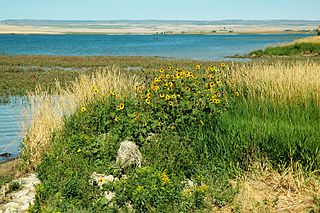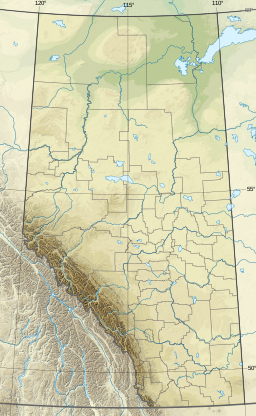
The Athabasca River is a river in Alberta, Canada, which originates at the Columbia Icefield in Jasper National Park and flows more than 1,231 km (765 mi) before emptying into Lake Athabasca. Much of the land along its banks is protected in national and provincial parks, and the river is designated a Canadian Heritage River for its historical and cultural importance. The scenic Athabasca Falls is located about 30 km (19 mi) upstream from Jasper.

Parkland County is a municipal district in central Alberta, Canada. Located west of Edmonton in Census Division No. 11, its municipal office, Parkland County Centre, is located 0.25 km (0.16 mi) north of the Town of Stony Plain on Highway 779.

Bow Valley Provincial Park is a provincial park in Alberta, Canada. Established in 1959 in the arch of the Bow River at its confluence with the Kananaskis River, the park is one park of many within the Kananaskis Country park system.
Spring Lake, originally named Edmonton Beach, is a village in central Alberta, Canada. It is located on the eastern shore of Spring Lake, approximately 20 km (12 mi) and 40 km (25 mi) west of the cities of Spruce Grove and Edmonton respectively. Hasse Lake is located 6 km (3.7 mi) southwest of Spring Lake. It was known as the Summer Village of Edmonton Beach from 1959 to 1999.
Sylvan Lake is a large lake in central Alberta, Canada. The resort town of Sylvan Lake is established on the shores of the lake, west of the city of Red Deer.

Pigeon Lake is a lake in central Alberta, Canada that straddles the boundary between Leduc County and the County of Wetaskiwin No. 10. It is located close to Edmonton, Leduc and Wetaskiwin. Communities located along the lakeshore include Pigeon Lake Indian Reserve 138A, ten summer villages, and four unincorporated communities.

The Sikome Aquatic Facility, commonly referred to as Sikome Lake, is a man-made lake in the city of Calgary, Alberta, Canada. It is located in the southeast quadrant of the city, within the Fish Creek Provincial Park, and is part of the Bow River basin. It lies at an elevation of 1,005 m (3,297 ft) and has a surface of 0.4 km2.

McGregor Lake is an elongated reservoir in Southern Alberta. McGregor Lake was created in 1920 by the completion of two dams bracketing water flowing through in Snake Valley. It is situated 100 km (62 mi) southeast of Calgary in the Vulcan County.
Crystal Springs is a summer village in Alberta, Canada. It is located on the southeast shores of Pigeon Lake, 1.2 km (0.75 mi) north of Highway 13. The community borders the Summer Village of Grandview to the northwest and the Village at Pigeon Lake to the south.

Airdrie Transit is a public transportation system which serves the city of Airdrie, Alberta, Canada, which is located just north of Calgary within the Calgary–Edmonton Corridor. Service consists of the Intercity Express (ICE) regional transit service, three conventional fixed routes within Airdrie and ACCESS Airdrie a paratransit service.

The Onion Lake Cree Nation is a Plains Cree First Nations band government in Canada, straddling the Alberta/Saskatchewan provincial border approximately 50 km (31 mi) north of the City of Lloydminster.

Goose Lake, also known as Lone Pine, is a hamlet in northwest Alberta, Canada within Woodlands County. It is located approximately 37 kilometres (23 mi) northeast of Highway 43 and 136 kilometres (85 mi) northwest of Edmonton.
Thunder Lake is a hamlet in central Alberta within the County of Barrhead No. 11. It is located on the eastern shore of Thunder Lake, just south of Thunder Lake Provincial Park, and is about 5 kilometres (3.1 mi) west of Highway 18 and approximately 21 kilometres (13 mi) west of Barrhead.
Tulliby Lake is a hamlet in central Alberta, Canada within the County of Vermilion River. It is located approximately 23 kilometres (14 mi) north of Highway 45 and 50 kilometres (31 mi) northwest of Lloydminster.
Village at Pigeon Lake is a hamlet in central Alberta, Canada within the County of Wetaskiwin No. 10. It is located 0.3 kilometres (0.19 mi) north of Highway 13, approximately 44 kilometres (27 mi) west of Wetaskiwin.
Hubbles Lake is a lake in Alberta. It is in Parkland County, Alberta, Canada, and is approximately a 20-minute drive on Highway 16 westward out of deep Edmonton.
Lac St. Cyr is a lake in the County of St. Paul No. 19, Alberta. The lake is near the town of St. Paul and since 1951 has been used as a source of water. In 1978, seasonal pumping of water from the North Saskatchewan River into the lake was begun to address a fall in the water level.










